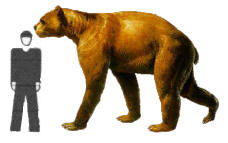
November 30, 2006
Cryptozoologist Craig Heinselman of Peterborough, New Hampshire, shares a long commentary on his reaction to my recent blogs on black and white squirrels and more, which may be found by clicking here.

Heinselman writes:
Part of the interest as well in these “biological curiosities,” is that they can allow for correlations to perception of people to a situation, acceptance of an oddity or other sociological differences. Whereas a “Bigfoot” report (another potential “biological curiosity”) can bring forth more laughter than data. So, the curiosities are a side interest in sociological, psychological and even cultural anthropology for those reasons.
Following what was mentioned though in Loren’s blog, the placement of certain generalized rules can also be utilized. These can allow researchers to determine, in part, whether a report is consistent with biological behavior.
These are general rules, as they do not apply in every case. And, these rules have been utilized before in analysis, take for instance the following example references:
George Gill’s “Population Clines of the North American Sasquatch as Evidence by Track Lengths and Estimated Structures” (Manlike Monsters on Trial, 1980)
Wolf Fahrenbach’s “Sasquatch: Size, Scaling and Statistics (Cryptozoology Volume 13, 1997/1998)
Craig Heinselman’s “Eastern Sasquatch Analysis: Potential Patterns or Dubious Data? (2001)
Bergmann’s Rule: geographic races of a species possessing smaller body size are found in the warmer parts of the range, and races of larger body size in cooler parts.
Gloger’s Rule: dark pigments increase in races of animals living in warm and humid habitats.
Rensch’s Rule: the ratio between the sizes of the sexes is related to body size.
Allen’s Rule: certain extremities of animals are relatively shorter in the cooler parts of a species’ range than in the warmer parts. (meaning ears, noses, and so forth, not necessarily “limbs”).
These rules can allow for a connection of sorts, both in determining the potential likelihood of a population (native) in an area, likelihood of a misidentification, and so forth.
This can turn the “hunt” for an abnormality into an evaluation of the evidence against a baseline. It can help, not eliminate, suppositions, and can also assist in identifying patterns (or lack there-of, which is a pattern in and of itself).

So, yes “biological curiosities” have a place on the outskirts of cryptozoology, but are still a portion of it. They are parts of explorations into reports (like Loren mentioned on melanistic felines), but they are also a tool to determine whether an actual reported “cryptid” may be real or fictitious, after all a living population of animals, man, or what-have-you, will at some time exhibit a abhorrent biological behavior (a mutation if you will). We have “white bigfoot” reports for example while most reports are of a darker colored one……
Cryptozoology can be as large, or small, as one wants it to be and can subsects as well. Zoology is a broad subject range, but has subsects as well (mammalogy, herpetology, etc), so does Anthropology (physical and cultural, for example). So why should we limit cryptozoology to a certain level, when it already has facets of subsects (dracontology, hominology, cryptocetology, etc)?
Call them “cryptocuriositas” or “biological curiosities” or “exotic zoology,” they still have a place.
Again, thanks to Craig Heinselman for the above insights. – Loren
About Loren Coleman
Loren Coleman is one of the world’s leading cryptozoologists, some say “the” leading living cryptozoologist. Certainly, he is acknowledged as the current living American researcher and writer who has most popularized cryptozoology in the late 20th and early 21st centuries.
Starting his fieldwork and investigations in 1960, after traveling and trekking extensively in pursuit of cryptozoological mysteries, Coleman began writing to share his experiences in 1969. An honorary member of Ivan T. Sanderson’s Society for the Investigation of the Unexplained in the 1970s, Coleman has been bestowed with similar honorary memberships of the North Idaho College Cryptozoology Club in 1983, and in subsequent years, that of the British Columbia Scientific Cryptozoology Club, CryptoSafari International, and other international organizations. He was also a Life Member and Benefactor of the International Society of Cryptozoology (now-defunct).
Loren Coleman’s daily blog, as a member of the Cryptomundo Team, served as an ongoing avenue of communication for the ever-growing body of cryptozoo news from 2005 through 2013. He returned as an infrequent contributor beginning Halloween week of 2015.
Coleman is the founder in 2003, and current director of the International Cryptozoology Museum in Portland, Maine.
Filed under Breaking News, Cryptomundo Exclusive, CryptoZoo News, Cryptozoologists, Cryptozoology, Evidence, Forensic Science